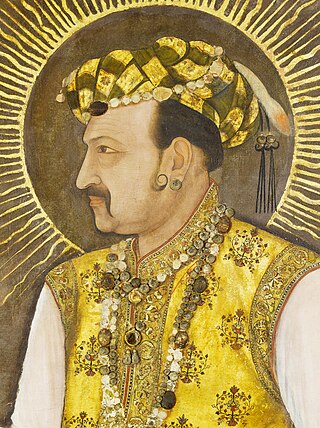
Nur-ud-Din Muhammad Salim, known by his imperial name Jahangir, was the fourth Mughal Emperor, who ruled from 1605 till his death in 1627.

Mirza Shahab-ud-Din Muhammad Khurram, also known as Shah Jahan I, was the fifth Mughal emperor, reigning from 1628 until 1658. During his reign, the Mughals reached the peak of their architectural and cultural achievements.

Mumtaz Mahal was the empress consort of Mughal Empire from 1628 to 1631 as the chief consort of the fifth Mughal emperor, Shah Jahan. The Taj Mahal in Agra, often cited as one of the Wonders of the World, was commissioned by her husband to act as her tomb.

Mirza Mu'izz-ud-Din Beg Muhammad Khan, better known by his title Jahandar Shah, was briefly the ninth Mughal emperor from 1712 to 1713. He was the son of emperor Bahadur Shah I, and the grandson of emperor Aurangzeb.

Jahanara Begum was a princess of the Mughal Empire. She was the second and the eldest surviving child of Mughal Emperor Shah Jahan and Mumtaz Mahal.
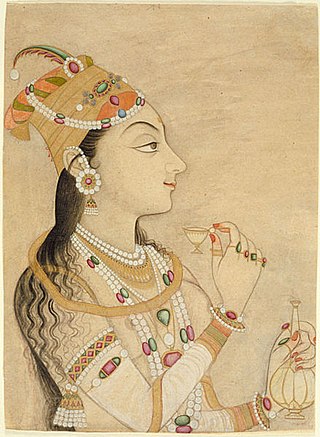
Nur Jahan, born Mehr-un-Nissa was the twentieth wife and chief consort of the Mughal emperor Jahangir.
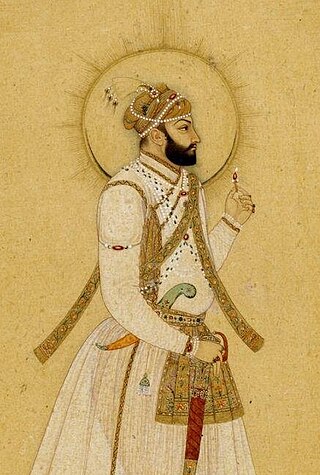
Farrukhsiyar, also spelled as Farrukh Siyar, was the tenth Mughal Emperor from 1713 to 1719. He rose to the throne after deposing his uncle Jahandar Shah. He was an emperor only in name, with all effective power in the hands of the courtier Sayyid brothers.
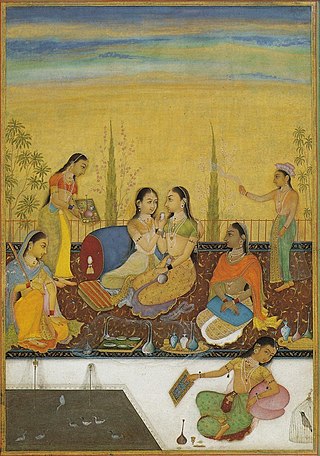
Zenana literally meaning "of the women" or "pertaining to women", in the Persian language contextually refers to the part of a house belonging to a Muslim, Sikh, or Hindu family in the Indian subcontinent, which is reserved for the women of the household. The zenana was a product of Indo-Islamic culture and was commonly found in aristocratic Muslim families. Due to prolonged interactions between Hindus and Muslims, upper-class Hindu households, inclined to imitate elite cultural trends, also embraced these designated spaces. The zenana were the inner rooms of a house where the women of the family lived and where men and strangers were not allowed to enter. The outer apartments for guests and men are called the mardana. Conceptually in those that practise purdah, it is the equivalent in the Indian subcontinent of the harem.

Mariam-uz-Zamani ;, commonly known by the misnomer Jodha Bai, was the chief consort and principal Hindu wife as well as the favourite wife of the third Mughal emperor, Akbar. She was also the longest-serving Hindu empress of the Mughal Empire with a tenure of forty-three years (1562–1605).
Darogas were police officials in the Mughal Empire and the British Raj. In the Mughal Empire, a daroga was superintendent of the "slaves" of a Mughal monarch.

Roshanara Garden is a Mughal-era garden built by Roshanara Begum, the second daughter of the Mughal emperor Shah Jahan. It is situated in Shakti Nagar near Kamla Nagar Clock Tower and North Campus of University of Delhi. It is one of the biggest gardens in Delhi having a great variety of plants, some imported from Japan. The lake inside the garden is visited by migratory birds during winters and is a popular site for bird watching.

Manavati Bai, also spelled Manvati Bai,, better known by her title, Jagat Gosain, was the second wife and the empress consort of the fourth Mughal emperor Jahangir and the mother of his successor, Shah Jahan.
Ruqaiya Sultan Begum was the first wife and one of the chief consorts of the third Mughal emperor, Akbar.

Lal Bangla are two imperial late-Mughal mausoleums located in Delhi, India, that are that protected monument under the Archaeological Survey of India.
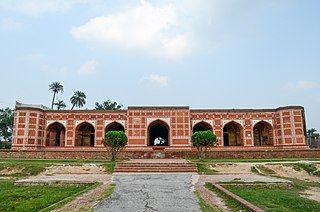
The Tomb of Nur Jahan is a 17th-century mausoleum in Lahore, Pakistan, that was built for the Mughal empress Nur Jahan. The tomb's marble was plundered during the Sikh era in 18th century for use at the Golden Temple in Amritsar. The red sandstone mausoleum, along with the nearby tomb of Jahangir, tomb of Asif Khan, and Akbari Sarai, forms part of an ensemble of Mughal monuments in Lahore's Shahdara Bagh.

The Mughal Harem was the harem of Mughal emperors of the Indian subcontinent. The term originated with the Near East, meaning a "forbidden place; sacrosanct, sanctum", and etymologically related to the Arabic حريم ḥarīm, "a sacred inviolable place; female members of the family" and حرام ḥarām, "forbidden; sacred". It has the same meaning as the Turkish word seraglio and the Persian word zenana. It is also similar to the Sanskrit word anthapura, meaning ‘the inner apartment’ of the household. It came to mean the sphere of women in what was usually a polygynous household and their segregated quarters which were forbidden to men.
During the Mughal Dynasty, urdubegis were the class of women assigned to protect the emperor and inhabitants of the zenana.
Mahaldars in the Mughal Empire were the chief officers of the imperial harem. Chosen from the ranks of the darogha administrators of the zenana, the mahaldar was responsible for maintaining order in this large community of women. Niccolao Manucci writes that "the way in which these kings are waited on deserves mention. For just as the king has his officers outside, he has the same among the fair sex within the Mahal".
Nur-un-Nissa Begum was the first wife and chief consort of Mughal emperor Bahadur Shah I.
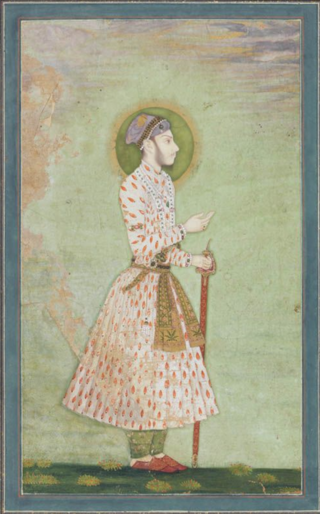
Azz-ud-Din Mirza was a Mughal prince and son of emperor Jahandar Shah. He accompanied his father to Lahore during the 1707 Mughal war of succession. In 1714, he was blinded by the emperor Farrukhsiyar.
















